Abstract
The growth of Torulopsis glabrata was inhibited in glucose-peptone broth containing 10 to 20% normal human serum. Addition of iron to the medium diminshed the fungistatic effect. The intracellular growth of T. glabrata was remarkably restricted within mouse macrophages maintained in vitro, but this growth restriction was not caused by the limitation of iron imposed by the serum in the medium. The intracellular growth of T. glabrata within a very small percentage of the macrophages was not obviously related to the failure of lysosomal fusion to the phagosomes in those cells. The studies did not permit definite conclusions regarding the viability of the inhibited yeasts, but results suggested that a large portion of them survived. Potentially misleading artifacts of the technique for assessment of the intracellular behavior of the fungus were detected and are discussed.
Full text
PDF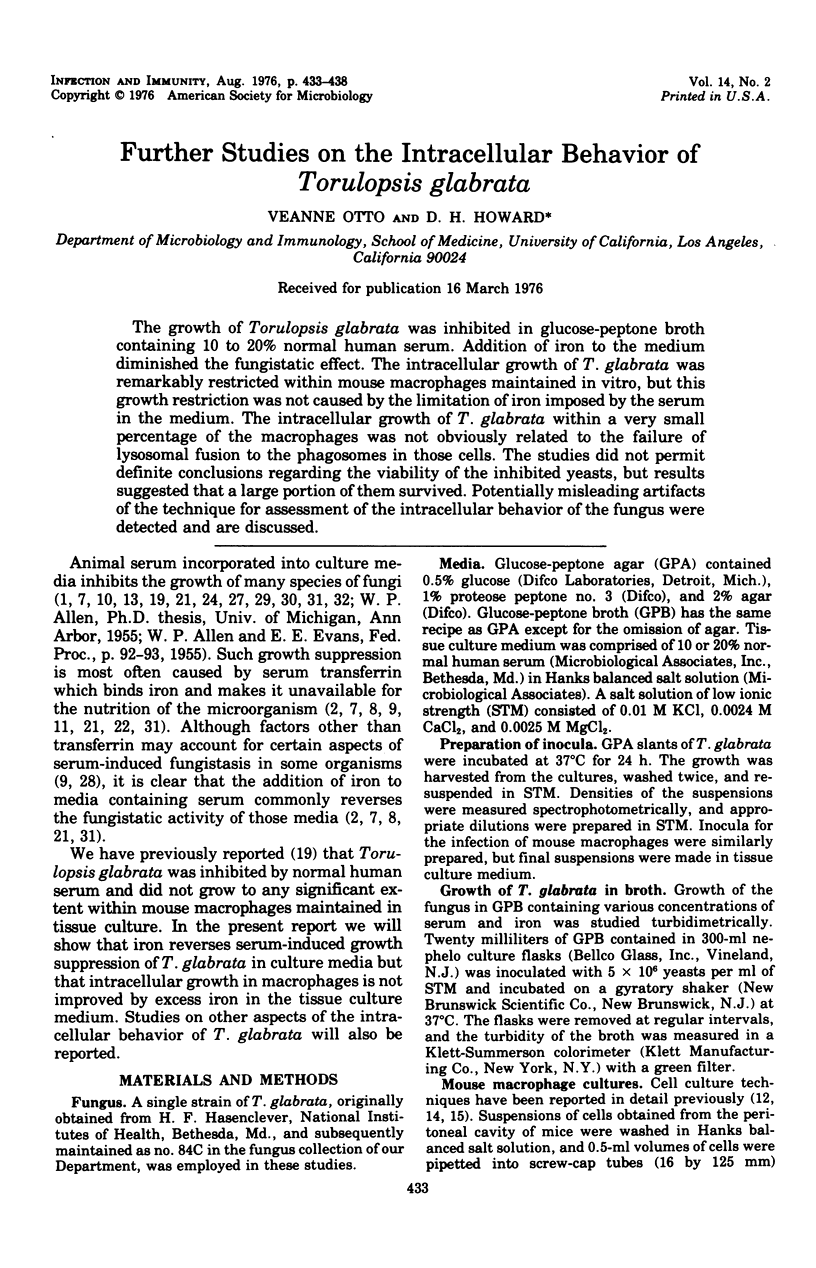
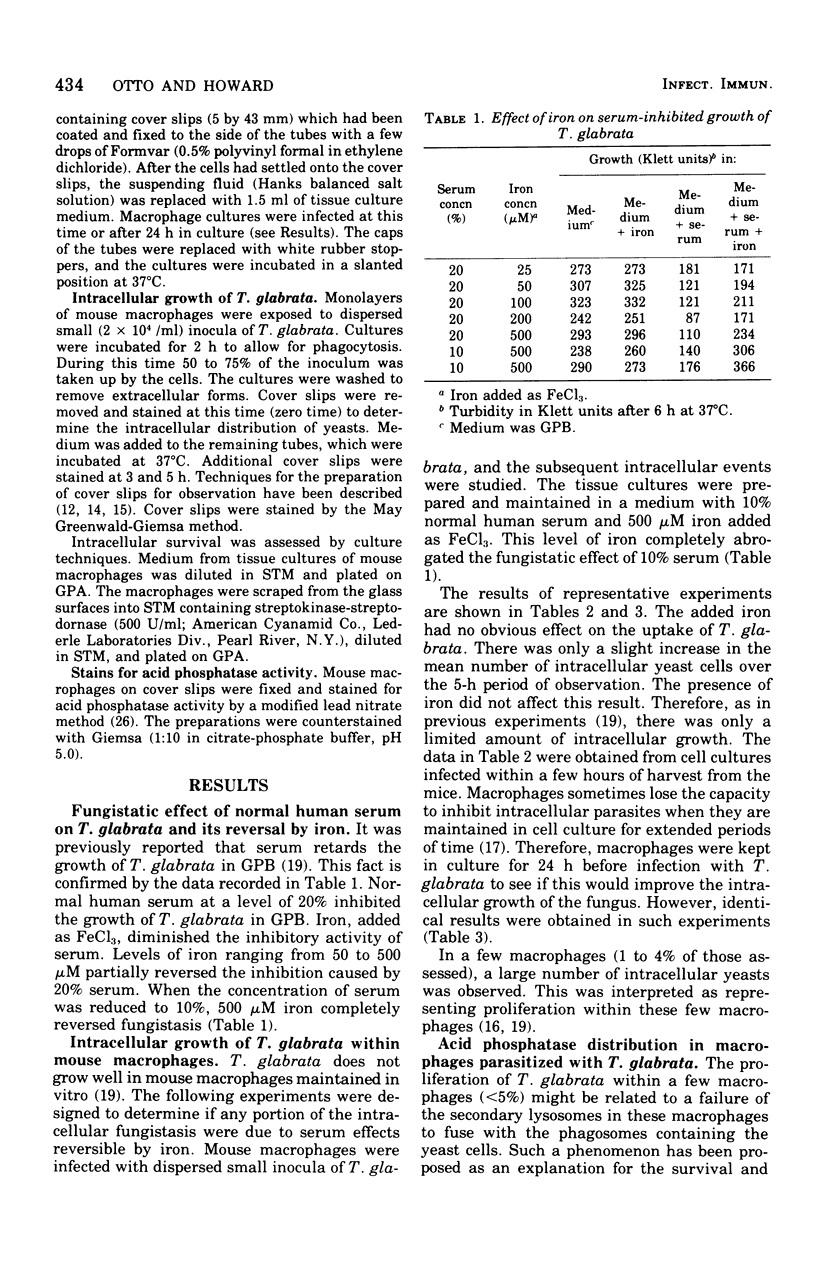
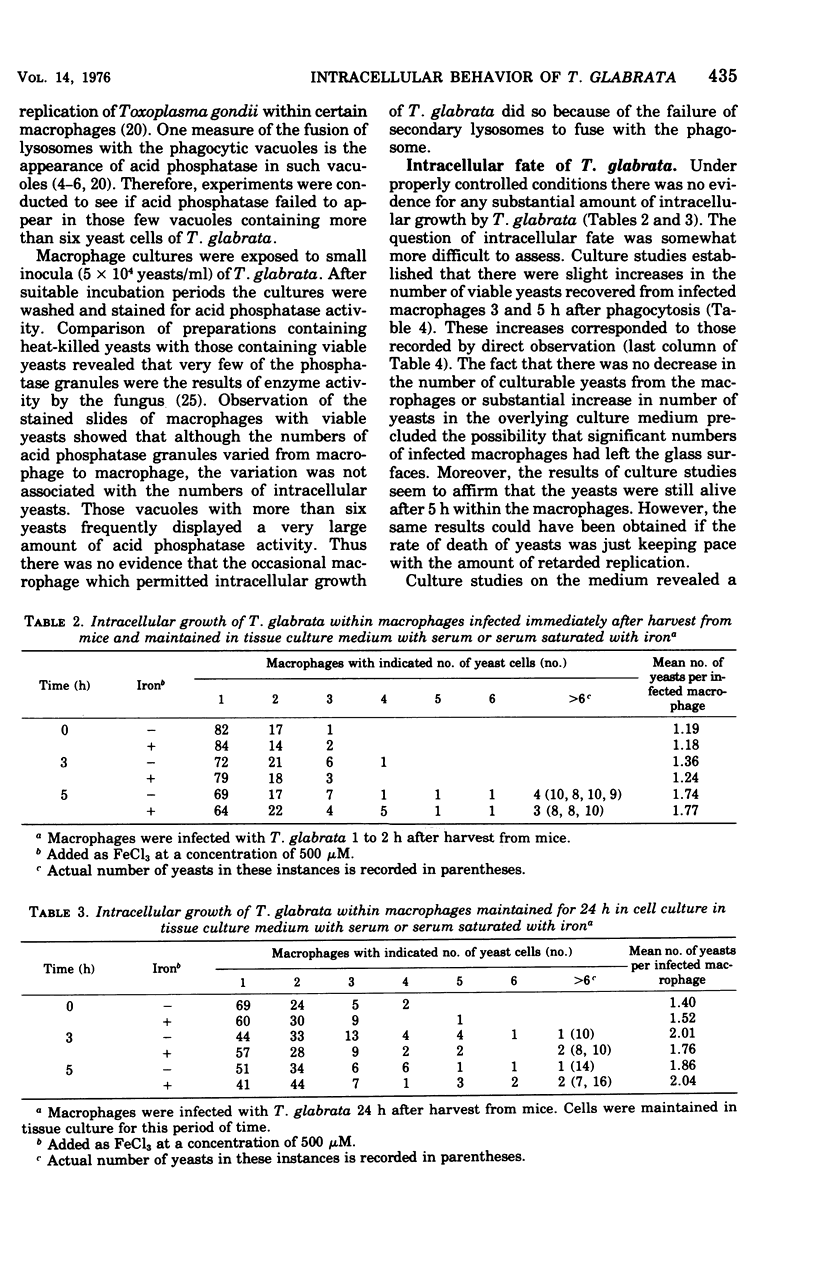
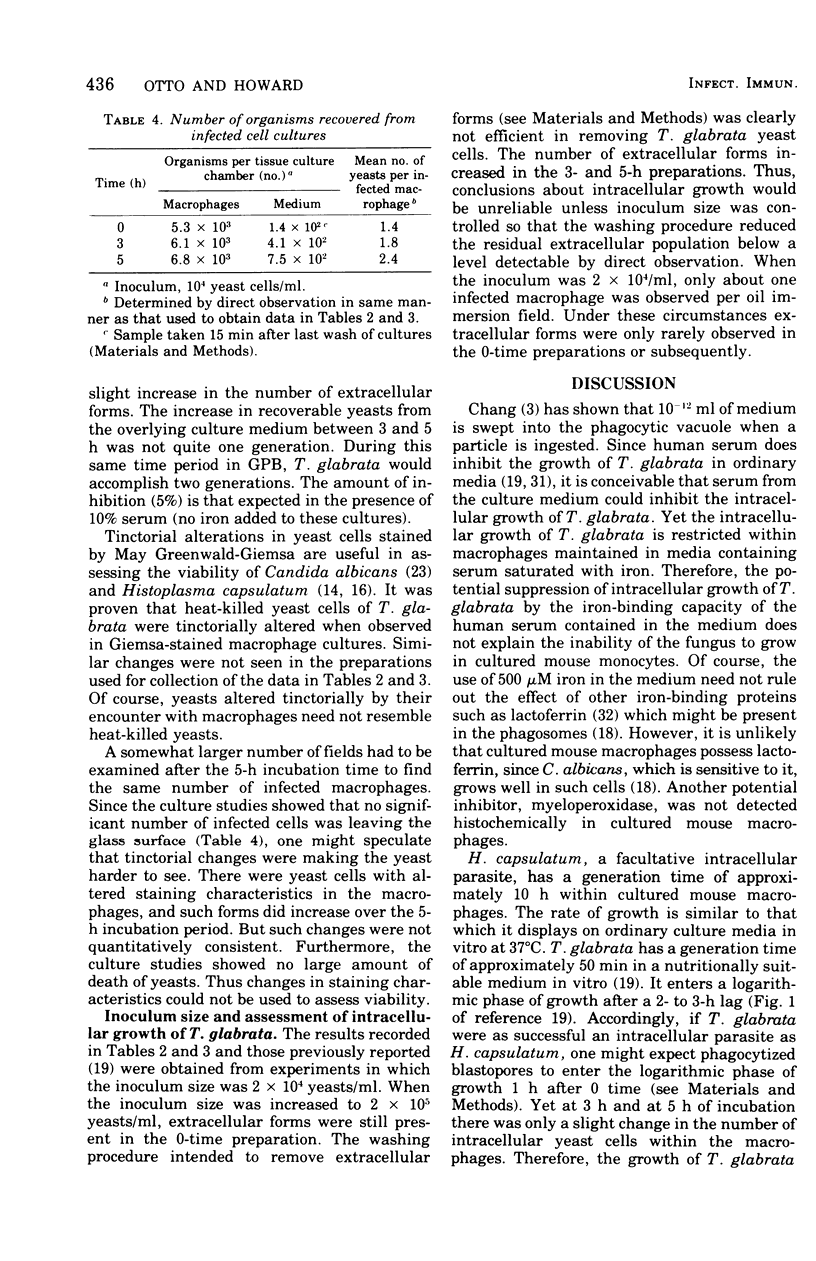
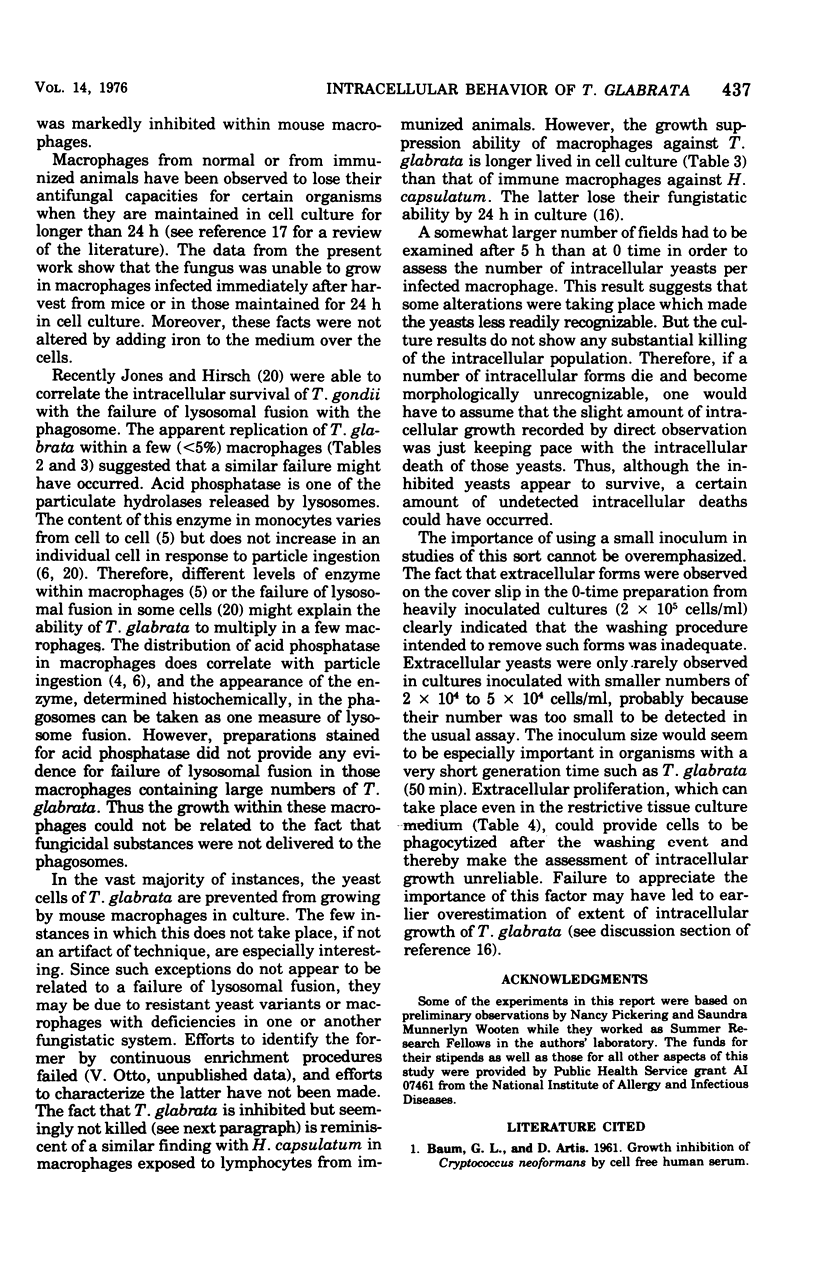
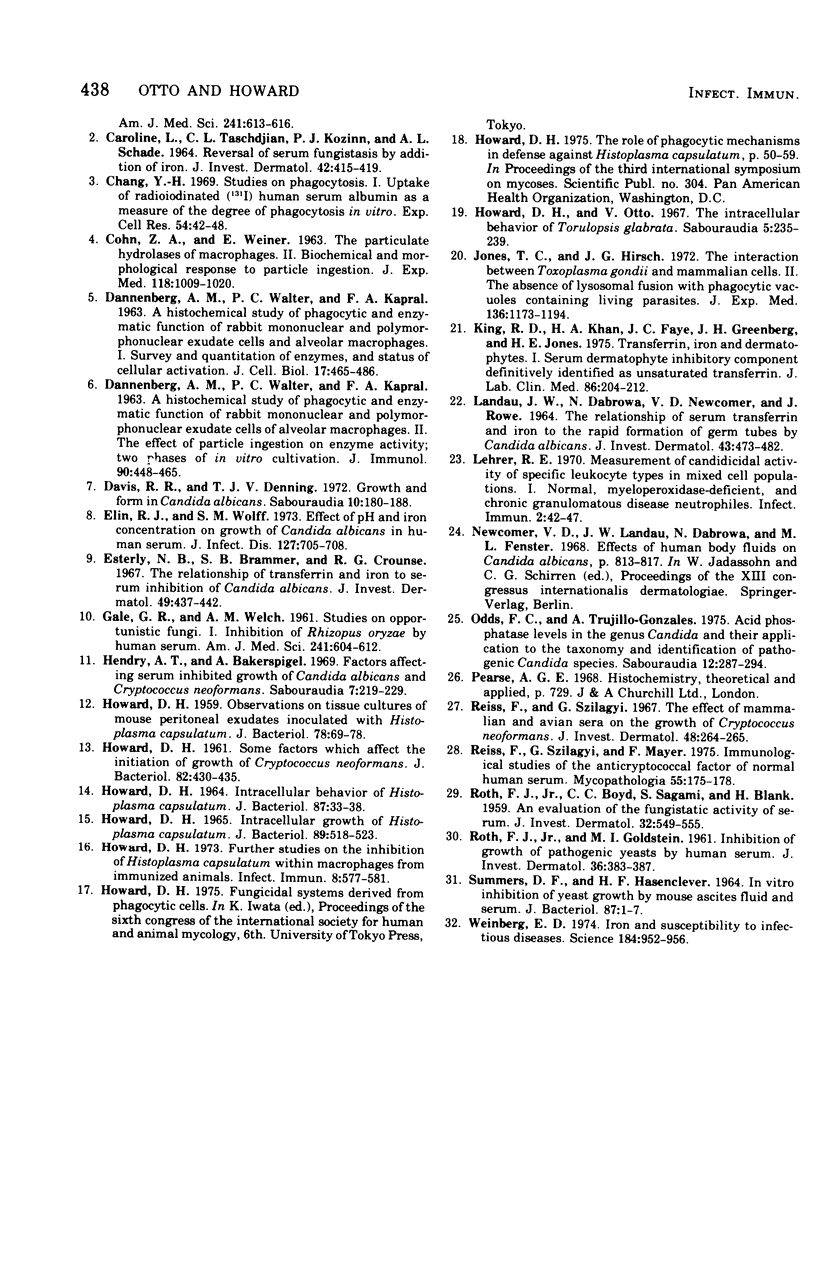
Selected References
These references are in PubMed. This may not be the complete list of references from this article.
- CAROLINE L., TASCHDJIAN C. L., KOZINN P. J., SCHADE A. L. REVERSAL OF SERUM FUNGISTASIS BY ADDITION OF IRON. J Invest Dermatol. 1964 Jun;42:415–419. doi: 10.1038/jid.1964.90. [DOI] [PubMed] [Google Scholar]
- COHN Z. A., WIENER E. THE PARTICULATE HYDROLASES OF MACROPHAGES. II. BIOCHEMICAL AND MORPHOLOGICAL RESPONSE TO PARTICLE INGESTION. J Exp Med. 1963 Dec 1;118:1009–1020. doi: 10.1084/jem.118.6.1009. [DOI] [PMC free article] [PubMed] [Google Scholar]
- Chang Y. H. Studies on phagocytosis. I. Uptake of radio-iodinated (131-I) human serum albumin as a measure of the degree of phagocytosis in vitro. Exp Cell Res. 1969 Jan;54(1):42–48. doi: 10.1016/0014-4827(69)90290-0. [DOI] [PubMed] [Google Scholar]
- DANNENBERG A. M., Jr, BURSTONE M. S., WALTER P. C., KINSLEY J. W. A histochemical study of phagocytic and enzymatic functions of rabbit mononuclear and polymorphonuclear exudate cells and alveolar macrophages. I. Survey and quantitation of enzymes, and states of cellular activation. J Cell Biol. 1963 Jun;17:465–486. doi: 10.1083/jcb.17.3.465. [DOI] [PMC free article] [PubMed] [Google Scholar]
- Davies R. R., Denning T. J. Growth and form in Candida albicans. Sabouraudia. 1972 Jul;10(2):180–188. [PubMed] [Google Scholar]
- Elin R. J., Wolff S. M. Effect of pH and iron concentration on growth of Candida albicans in human serum. J Infect Dis. 1973 Jun;127(6):705–708. doi: 10.1093/infdis/127.6.705. [DOI] [PubMed] [Google Scholar]
- Esterly N. B., Brammer S. R., Crounse R. G. The relationship of transferrin and iron to serum inhibition of Candida albicans. J Invest Dermatol. 1967 Nov;49(5):437–442. [PubMed] [Google Scholar]
- GALE G. R., WELCH A. M. Studies of opportunistic fungi. I. Inhibition of Rhizopus oryzae by human serum. Am J Med Sci. 1961 May;241:604–612. [PubMed] [Google Scholar]
- HOWARD D. H. INTRACELLULAR BEHAVIOR OF HISTOPLASMA CAPSULATUM. J Bacteriol. 1964 Jan;87:33–38. doi: 10.1128/jb.87.1.33-38.1964. [DOI] [PMC free article] [PubMed] [Google Scholar]
- HOWARD D. H. INTRACELLULAR GROWTH OF HISTOPLASMA CAPSULATUM. J Bacteriol. 1965 Feb;89:518–523. doi: 10.1128/jb.89.2.518-523.1965. [DOI] [PMC free article] [PubMed] [Google Scholar]
- HOWARD D. H. Observations on tissue cultures of mouse peritoneal exudates inoculated with Histoplasma capsulatum. J Bacteriol. 1959 Jul;78(1):69–78. doi: 10.1128/jb.78.1.69-78.1959. [DOI] [PMC free article] [PubMed] [Google Scholar]
- HOWARD D. H. Some factors which affect the initiation of growth of Cryptococcus neoformans. J Bacteriol. 1961 Sep;82:430–435. doi: 10.1128/jb.82.3.430-435.1961. [DOI] [PMC free article] [PubMed] [Google Scholar]
- Hendry A. T., Bakerspigel A. Factors affecting serum inhibited growth of Candida albicans and Cryptococcus neoformans. Sabouraudia. 1969 Oct;7(3):219–229. [PubMed] [Google Scholar]
- Howard D. H. Further studies on the inhibition of Histoplasma capsulatum within macrophages from immunized animals. Infect Immun. 1973 Oct;8(4):577–581. doi: 10.1128/iai.8.4.577-581.1973. [DOI] [PMC free article] [PubMed] [Google Scholar]
- Howard D. H., Otto V. The intracellular behavior of Torulopsis glabrata. Sabouraudia. 1967 Feb;5(3):235–239. [PubMed] [Google Scholar]
- Jones T. C., Hirsch J. G. The interaction between Toxoplasma gondii and mammalian cells. II. The absence of lysosomal fusion with phagocytic vacuoles containing living parasites. J Exp Med. 1972 Nov 1;136(5):1173–1194. doi: 10.1084/jem.136.5.1173. [DOI] [PMC free article] [PubMed] [Google Scholar]
- King R. D., Khan H. A., Foye J. C., Greenberg J. H., Jones H. E. Transferrin, iron, and dermatophytes. I. Serum dematophyte inhibitory component definitively identified as unsaturated transferrin. J Lab Clin Med. 1975 Aug;86(2):204–212. [PubMed] [Google Scholar]
- LANDAU J. W., DABROWA N., NEWCOMER V. D., ROWE J. R. THE RELATIONSHIP OF SERUM TRANSFERRIN AND IRON TO THE RAPID FORMATION OF GERM TUBES BY CANDIDA ALBICANS. J Invest Dermatol. 1964 Dec;43:473–482. [PubMed] [Google Scholar]
- Lehrer R. I. Measurement of candidacidal activity of specific leukocyte types in mixed cell populations I. Normal, myeloperoxidase-deficient, and chronic granulomatous disease neutrophils. Infect Immun. 1970 Jul;2(1):42–47. doi: 10.1128/iai.2.1.42-47.1970. [DOI] [PMC free article] [PubMed] [Google Scholar]
- Odds F. C., Trujillo-Gonzales A. Acid phosphatase levels in the genus Candida and their application to the taxonomy and identification of pathogenic Candida species. Sabouraudia. 1974 Nov;12(3):287–294. [PubMed] [Google Scholar]
- ROTH F. J., Jr, BOYD C. C., SAGAMI S., BLANK H. An evaluation of the fungistatic activity of serum. J Invest Dermatol. 1959 May;32(5):549–556. doi: 10.1038/jid.1959.92. [DOI] [PubMed] [Google Scholar]
- ROTH F. J., Jr, GOLDSTEIN M. I. Inhibition of growth of pathogenic yeasts by human serum. J Invest Dermatol. 1961 May;36:383–387. doi: 10.1038/jid.1961.59. [DOI] [PubMed] [Google Scholar]
- Reiss F., Szilagyi G., Mayer E. Immunological studies of the anticryptococcal factor of normal human serum. Mycopathologia. 1975 Jun 14;55(3):175–178. doi: 10.1007/BF00491504. [DOI] [PubMed] [Google Scholar]
- Reiss F., Szilagyi G. The effect of mammalian and avian sera on the growth of Cryptococcus neoformans. J Invest Dermatol. 1967 Mar;48(3):264–265. doi: 10.1038/jid.1967.43. [DOI] [PubMed] [Google Scholar]
- SUMMERS D. F., HASENCLEVER H. F. IN VITRO INHIBITION OF YEAST GROWTH BY MOUSE ASCITES FLUID AND SERUM. J Bacteriol. 1964 Jan;87:1–7. doi: 10.1128/jb.87.1.1-7.1964. [DOI] [PMC free article] [PubMed] [Google Scholar]
- Weinberg E. D. Iron and susceptibility to infectious disease. Science. 1974 May 31;184(4140):952–956. doi: 10.1126/science.184.4140.952. [DOI] [PubMed] [Google Scholar]


